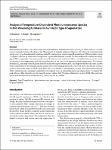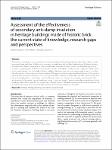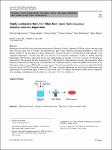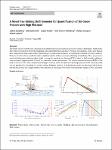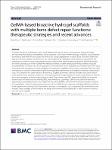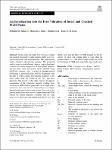Search
Author
- Manyk, T. (3)
- Murawski, K. (3)
- Baumgartner, Jörg (2)
- Guizani, Chamseddine (2)
- next >
Subject
Date issued
- 2023 (187)
Has File(s)
- true (187)
Search Results
Blast furnace ironmaking produces a reducing and carburizing atmosphere in the blast furnace which may lead to metal dusting. However, there is limited research on metal dusting under this particular atmosphere. This paper investigated metal dusting behaviors of ferritic Fe-(10, 20, 25)Cr and austenitic Fe-20Cr-(20, 33)Ni, Fe-25Cr-20Ni (wt.%) alloys at 550 and 650 °C in an Ar-33CO-7H2-7CO2-2H2O (vol.%) gas simulating a blast furnace operating condition. A relatively short reaction time, up to 100 h, was used to evaluate the initial stage of metal dusting of these alloys in the blast furnace gas condition. Severe metal dusting and coke deposition were observed at 550 °C, while no significant dusting but internal oxidation and carburization were observed at 650 °C. |
Photoluminescence (PL) is one of the commonly used methods to determine the energy gap (Eg
) of semiconductors. In order to use it correctly, however, the shape of the PL peak must be properly analyzed; otherwise, the value of Eg
is burdened with a large error. Eg
is often mistakenly attributed to the PL peak position, which in type-II superlattices (T2SLs) exhibits typical “S-shaped” behavior as a function of temperature, significantly different from the Varshni model used to define the energy gap of III-V compounds. The position peak of the PL relative to the real Eg
in T2SLs is red-shifted because of the carrier localization at low temperatures and blue-shifted because of the free carrier emission at high temperatures. To correctly determine Eg
, the shape of the PL peak ... |
Destruction caused by excessive moisture is a common problem in heritage buildings made of brick. Historic buildings usually have walls that of different constructions, i.e. walls with all joints filled, walls without filled vertical joints, and walls with a layered arrangement. Excessive moisture causes brick cavities, reduces the load-bearing capacity of walls, is unsightly, and can lead to the destruction of walls or the failure of a building. Secondary anti-damp insulation is used to protect the brick walls of historic buildings. However, there has not been enough research to confirm the effectiveness of secondary anti-damp insulation. This type of insulation is performed with the use of the injection method, with various factors (such as soils, the type of injection material, e... |
The current standard method of diagnosing coronavirus disease 2019 (COVID-19) involves uncomfortable and invasive nasopharyngeal (NP) sampling using cotton swabs (CS), which can be unsuitable for self-testing. Although mid-turbinate sampling is an alternative, it has a lower diagnostic yield than NP sampling. Nasal wash (NW) has a similar diagnostic yield to NP sampling, but is cumbersome to perform. In this study, we introduce a 3D printed fluidic swab (3DPFS) that enables easy NW sampling for COVID-19 testing with improved diagnostic yield. The 3DPFS comprises a swab head, microchannel, and socket that can be connected to a syringe containing 250 µL of NW solution. |
Ruthenium dioxide (RuO2) thin films were synthesized by Chemical Solution Deposition (CSD) on silicon substrates using only water and acetic acid as solvents. The microstructure, phase purity, electrical and optical properties as well as the thermal stability of the thin films have been characterized. The microstructure of the thin films strongly depends on the annealing temperature: A smooth thin film was achieved at an annealing temperature of 600 °C. Higher annealing temperatures (800 °C) led to radial grain growth and an inhomogeneous thin film. A very low resistivity of 0.89 µΩm was measured for a 220 nm-thick thin film prepared at 600 °C. The resistivity of the thin films increases with temperature, which indicates metallic behavior. |
The nature of snow and the ever-changing environment makes measuring friction on snow and ice challenging. Additionally, due to the low friction involved, the equipment used must exhibit high sensitivity. Previous investigations of ski–snow friction have ranged from small-scale model experiments performed in the laboratory to experiments with full-sized skis outdoors. However, few have been conducted under conditions similar to those encountered during actual skiing. Here, we present a novel sled tribometer which provides highly reproducible coefficient of friction (COF) values for full-sized skis gliding at relevant speeds (approximately 5.9 m/s) in a controlled indoor environment. The relative standard deviation (RSD) of the COF is as low as 0.5%. The continuous recording of veloc... |
Currently, the clinical treatment of critical bone defects attributed to various causes remains a great challenge, and repairing these defects with synthetic bone substitutes is the most common strategy. In general, tissue engineering materials that mimic the structural, mechanical and biological properties of natural bone have been extensively applied to fill bone defects and promote in situ bone regeneration. Hydrogels with extracellular matrix (ECM)-like properties are common tissue engineering materials, among which methacrylate-based gelatin (GelMA) hydrogels are widely used because of their tunable mechanical properties, excellent photocrosslinking capability and good biocompatibility. Owing to their lack of osteogenic activity, however, GelMA hydrogels are combined with other... |
Society 5.0 establishes innovations and innovativeness as the basic platforms for accelerating the development of solution-based strategies for the sustainability problems every society is facing. It features an interactive cycle operating at a society-wide level through which data are collected, analyzed and transformed into applicable technology for the real world. Transforming the current society into a super smart society requires in-depth knowledge of the Internet of Things, robotics and artificial intelligence. Being a member of the 4th industrial revolution is significant; however, it is equally important to alleviate the socioeconomic challenges associated with it and to maintain sustainability. From cellulose to carbon, fibers have utmost importance in technological applica... |
In this study, the linear free vibration of intact and cracked functionally graded material plates is investigated numerically and experimentally. The experimental work is limited to the isotropic materials. The numerical work is based on finite element, where a code is developed to obtain the natural frequencies of intact plates based on the first-order shear deformation theory (FSDT) using MATLAB software. Also, a model of through-cracked FGM plate is developed using ANSYS Workbench with the help of APDL coding. The material properties of the plates under study are graded in one, two, and three directions. The novelty of this study emerges through its examination of the synergistic impacts resulting from variations in FGM material properties, crack length, crack orientation, and c... |
In the evaluation of human epidermal growth factor receptor 2 (HER2) immunohistochemistry (IHC) — one of the standard biomarkers for breast cancer— visual assessment is laborious and subjective. Image analysis using whole slide image (WSI) could produce more consistent results; however, color variability in WSIs due to the choice of stain and scanning processes may impact image analysis. We therefore developed a calibration protocol to diminish the staining and scanning variations of WSI using two calibrator slides. The IHC calibrator slide (IHC-CS) contains peptide-coated microbeads with different concentrations. The color distribution obtained from the WSI of stained IHC-CS reflects the staining process and scanner characteristics. A color chart slide (CCS) is also useful for cali... |


